Florida is one of the states with a wide variety of native butterflies. The distinct climate in Southern Florida is also home to many migratory species.
Monarch, White Peacock, and Queen butterflies are some of the most common species in North America that are also native to Florida.
Southern Florida, Florida Keys, and peninsular Florida are home to hundreds of species of small and large butterflies.
Some of these butterflies are known for relying on very good mimicry techniques. They mimic larger species or other animals altogether.
A good percentage of Florida butterflies are detrimental to the ecosystem, especially through their caterpillars. These caterpillars can defoliate trees, flowers, bushes, and legumes.
Florida is also home to species that defoliate palmettos. Some of them are active throughout the year.
The following species of butterflies are most common in Florida.
Table of Contents
1. Gulf Fritillary

Gulf Fritillary butterflies (Dione vanillae) are native to Florida. This species is also found in nearby states but it’s Florida that host the butterflies as they migrate.
Spring and fall times are the most common periods when the Gulf Fritillary migrates within or towards Florida.
It moves North to come back South in the fall.
Apart from migrating habits, this species is further known for releasing certain chemicals that keep its predators away. These chemicals are particularly useful against small birds and other predators.
The butterfly species is identified by its vivid orange color. The dark orange coloring is specific to its forewings while its hindwings have light orange colors. Its body is also orange.
Black stripes and veins are also distinguished by the species.
Black and white eyespots are also seen on its wings, mainly to keep predators away. Small white areas are also specific to its head and the margins of the hindwings.
2. White Peacock

White Peacock butterflies (Anartia jatrophae) are native to multiple US states from Maryland down to Texas.
Florida is the state with the most White Peacocks. These butterflies love the weather and the humidity in the state.
They live close to the water in wetlands and they look for water hyssop to lay eggs on. This water plant is a familiar choice for laying eggs which the caterpillars of the species later consume.
Once emerged into adults, White Peacock butterflies feed on other plants such as shepherd’s needle.
White Peacock butterflies have a wingspan of more than 2 inches.
The species is identified by a gray and orange, orange, or yellow and orange color.
Dorsal coloring for the species is often a combination of orange with brown borders. Butterflies of this genus have multiple dark brown eyespots which are seen across the lighter colors across their wings.
Many see White Peacock butterflies as a butterfly with many morphs. In most cases, the color of the species changes with the same individual.
The winter season typically comes with faded colors while summertime is when the colors of the dorsal wings are more vivid.
3. Monarch

Florida is one of the few states where the common species of Monarch butterflies (Danaus plexippus) are seen throughout the year. This species has a known resting place here escaping cold winters in the North.
Monarch butterflies often undergo long migration processes in North America. Western and Eastern populations are described for the species but with almost no differences between them.
Eastern Monarchs are found in Florida where they migrate to and from towards Northern states.
Monarchs feed on all types of plants and flowers. They are commonly seen on various sunflower species.
They also lay eggs on host plants. Monarch larvae go through 5 instars before emerging as young yellow and black adults.
The species finally settles into an orange and black butterfly. Rare white and black morphs are seen within this species, especially with isolated populations.
Monarchs in Hawaii are white and black.
Mating is a long process in Monarchs and it starts in the air. Males chase females and force them to the ground to mate for up to an hour.
Some of the best places to see these butterflies are in open areas rich in milkweed.
4. Zebra Longwing

Zebra Longwing (Heliconius charithonia) is a type of native migratory butterfly in Florida. This species gets its name from its black and white wings which resemble the colors of a zebra.,
The species is found in high numbers across Peninsular Florida.
Butterflies of this genus are initially found around passionflowers where they lay eggs on. Migratory species can come from other areas to lay eggs as well.
Zebra longwing butterflies feed on various types of pollen and nectar. They do not favor one another.
Females are known to prefer nectar that has a higher amino acid profile, mainly for mating purposes.
Zebra Longwing butterflies might be easy to spot in the evening. They return to roost together which is a habitat that diminishes their potential predation.
Tens of Zebra Longwing butterflies are seen together to shelter themselves from direct attacks.
5. Common Buckeye

Common Buckeye butterflies (Junonia coenia) are native to Florida. While traced to its African roots, this species is properly established in the state.
It was a few decades ago that Common Buckeyes started migrating to outer Florida as well.
This is a small species known for its light brown wings with dark brown eyespots.
The species has orange and white ventral wings with small black eyespots.
Apart from eyespots, this species also absorbs toxins from its host plant to have a bad taste for potential predators.
Aggregation or the social-like gathering of butterflies is also specific to the Common Buckeye. This is a species known for its social nature which also limits the possibilities of predation.
Adult Common Buckeyes feed on yellow flowers. They have an eye that has already been visited by other species and avoid such plants.
6. Horace’s Duskywing
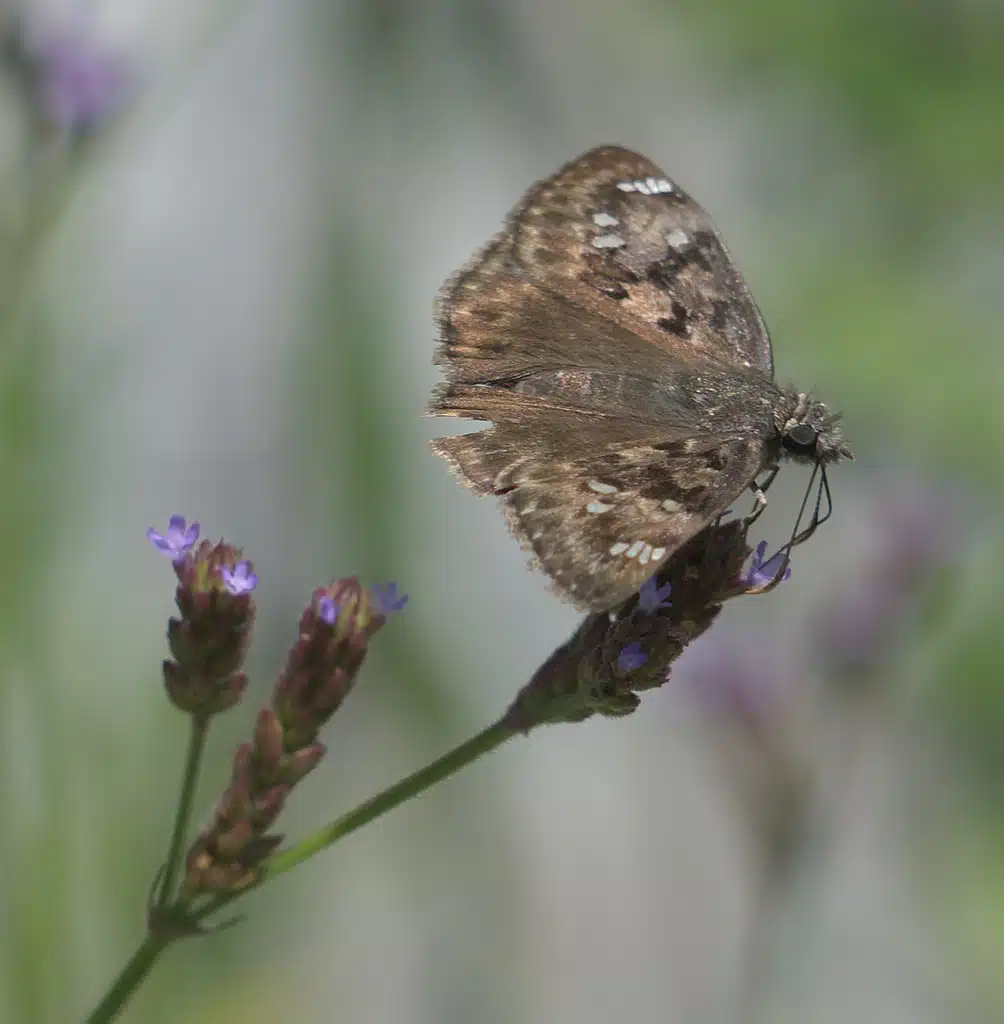
Open woodlands are some of the preferred habitats of Horace’s Duskywing butterflies (Erynnis horatius) in Florida.
This species is identified by its brown and dark brown wings with fine white margins.
Its presence is signaled outside of the state in all Eastern parts of the country.
Horace’s Duskywing are species of butterflies that use trees to lay eggs and as food for their caterpillars.
This species has a preference for species of oaks when it comes to laying eggs.
The number of broods this species has is 3 within Florida. It has 1 or 2 broods elsewhere.
Small flowers and shrubs are among the preferred food sources for the adult Horace’s Duskywing. These butterflies feed on dogbane but also peppermint, and goldenrod.
7. Eastern Giant Swallowtail
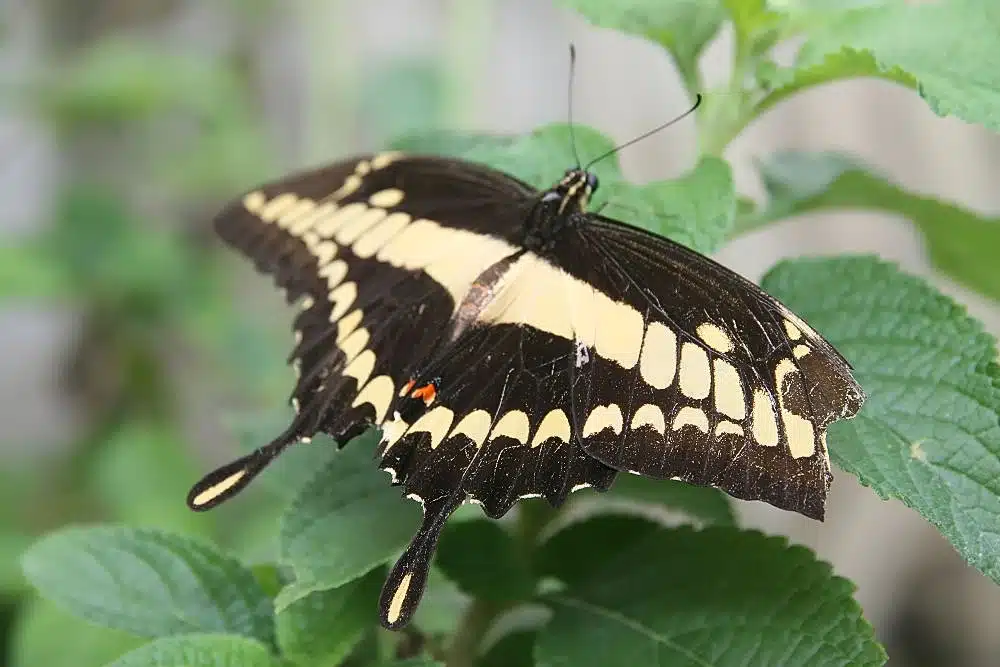
Eastern Giant Swallowtails (Papilio cresphontes) are some of the largest butterflies in Florida. This species is known for having a wingspan that can be as long as 5.5 inches.
Eastern Giant Swallowtail butterflies have striking black and yellow coloration. This species has mostly black wings with 2 yellow bands across the forewings and the hindwings.
Eastern Giant Swallowtails are very good at flying and they use these skills to their advantage when it comes to laying eggs.
Unlike Horace’s Duskywing, these butterflies can still fly at high altitude, often to lay eggs on tall trees such as prickly ash.
The damages Eastern Giant Swallowtails create can be considerable given the species can defoliate entire trees.
Citrus trees are often impacted by the species but adults might also live in woodlands.
Lantana and goldenrods in woodlands are often used as food by adults.
Insecticides are often the only solutions to keep Eastern Giant Swallowtails from invading crops to lay eggs.
8. Long-tailed Skipper
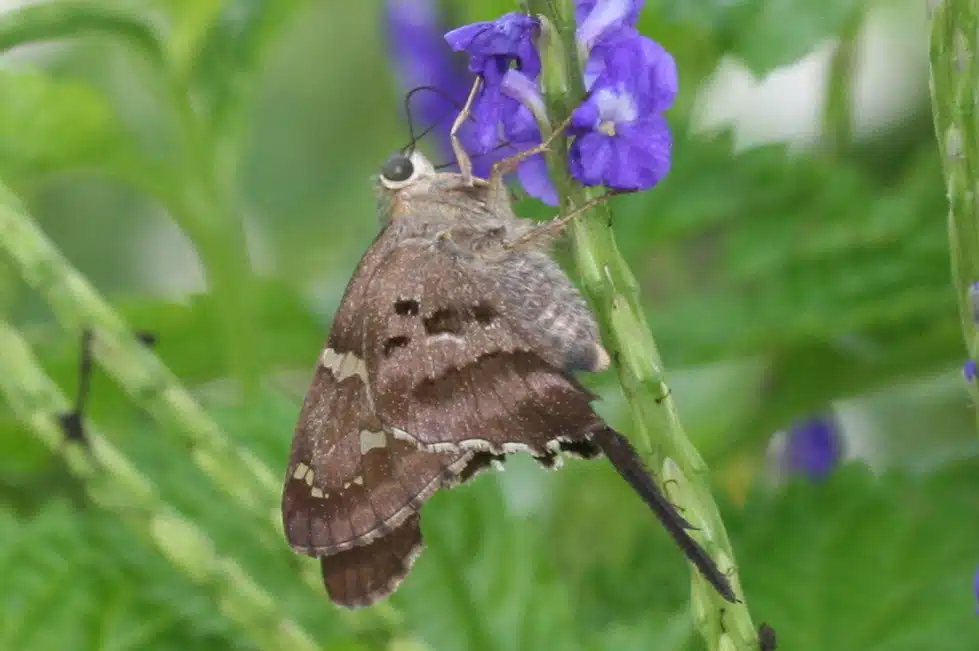
Long-tailed Skippers (Urbanus proteus) like it in Florida more than in other states. One of the results of their love for the warm climate of the state is having 2-3 broods per year here as opposed to a single brood elsewhere.
This species starts life as a green caterpillar with a brown head.
As it emerges into an adult it changes to brown and black colors. Its wings are mostly brown with yellow and black spots.
You can find Long-tailed Skippers all over the state. These butterflies are among the most common species in orchards.
They also inhabit woodlands and spaces next to woodlands.
Shepherds’ needle is among the favorite food sources for the adult Long-tailed skipper.
Various types of beans and hog peanuts are among the host species of its caterpillars.
9. Fiery Skipper
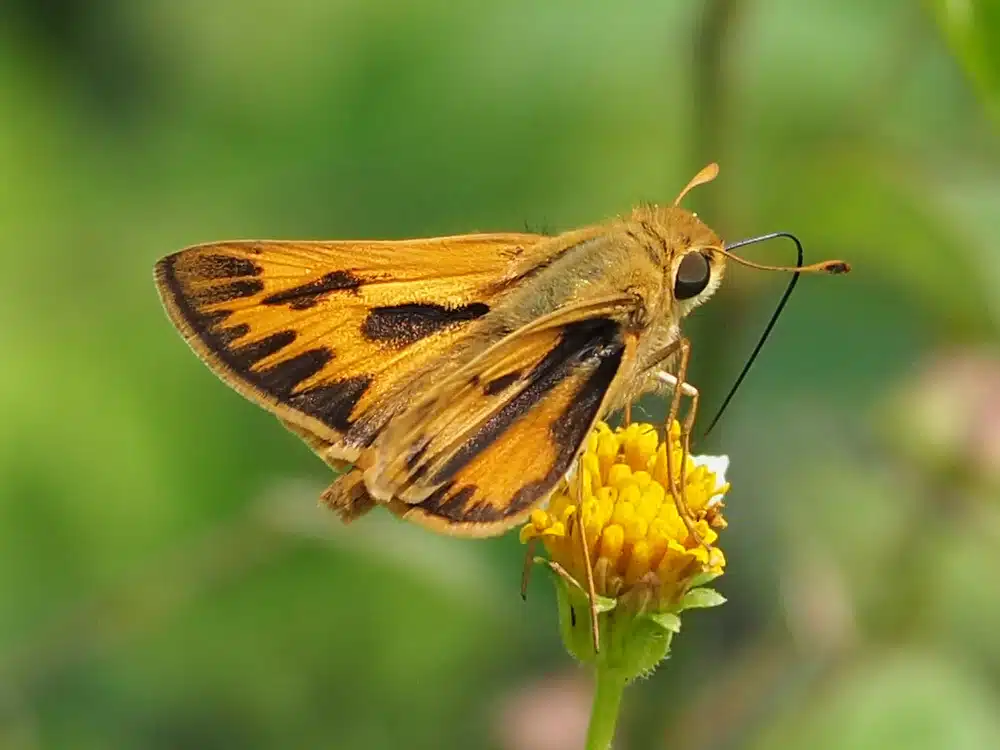
Fiery Skippers (Hylephila phyleus) are common in Florida where they can be a real threat to a wide range of grasses and lawns.
Caterpillars of the species tend to be highly destructive to lawns and decorative grasses without precautions.
Urban environments are the most common species to see this species. Your home might even attract its caterpillars if you grow Bermuda grass on the premises.
Fiery Skippers can be identified by the positioning and colors of their wings. These butterflies commonly fold their forewings up to create a triangular shape.
You can further identify this species by its yellow color with brown margins.
The underwings of the species are almost completely yellow while its body is also yellow with fine white lines across.
In extreme cases, this species should be controlled completely as it can invade bananas.
10. Queen

Queen butterflies (Danaus gilippus) are related to and similar to Monarch butterflies. These are also some of the largest butterflies in Florida and they routine grow to a wingspan of more than 80mm.
The color of the species can be light brown in certain areas, red-brown, or even orange in other areas.
Its wings are often subject to color changes according to their range. A light brown Queen butterfly is a common sight across the state.
This species has black veins and wide black margins. White spots are seen across its black margins but they can also be seen across the colored sections of the wings.
Queen butterflies mostly feed on milkweed and dogbane. This species prefers milkweed and dogbane to other plants and other food sources.
Pollen and nectar are their preferred foods. Queen butterflies can also consume other types of food including dried fruit and dung.
When not feeding, Queen butterflies are mainly interested in mating.
High numbers of the species are typically tied to its frequent mating strategies. Male Queen butterflies look for suitable females to mate with during the day.
The female Queen butterfly mates between 10 and 15 times in its lifespan.
11. Ceraunus Blue
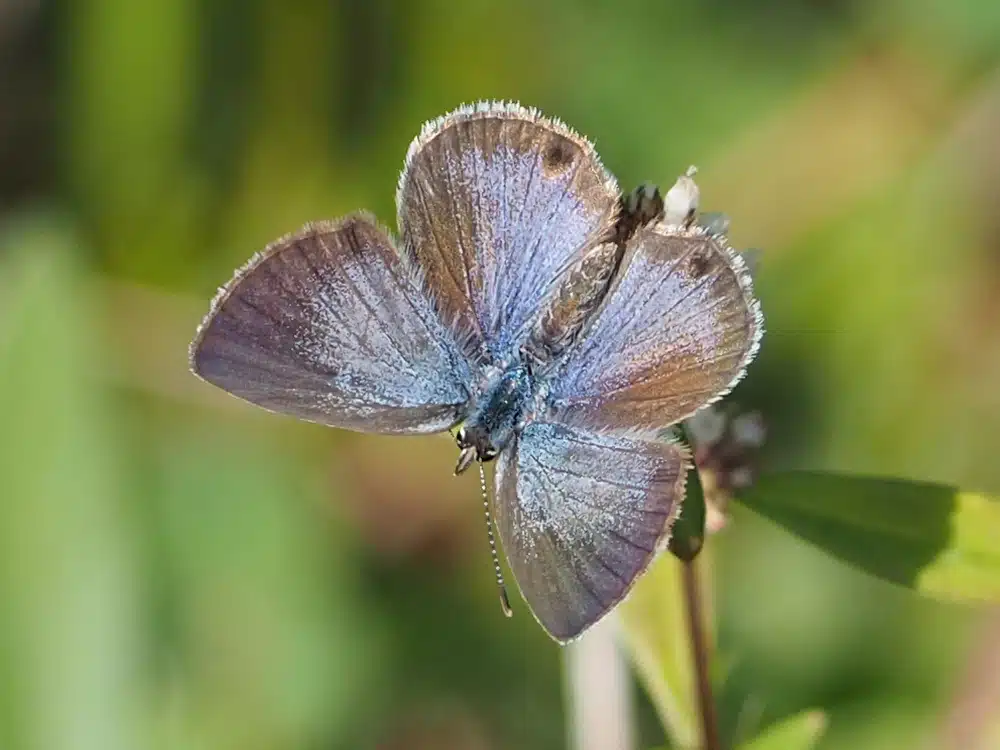
Ceranus Blue butterflies (Hemiargus ceraunus) are a small species with a varying wingspan between 20 and 30mm. This species lives in high numbers across Central America and also in Southern parts of Florida.
Butterflies of the Ceraunus Blue genus are among the most common species that have light brown coloring and black eyespots.
These eyespots make this small species look considerably larger and be perceived as a larger species.
These butterflies are known for laying eggs on herbaceous peas. Their tiny flattened eggs then turn into brown larvae.
Common in open areas, Ceraunus Blue butterflies have multiple broods per year in Florida, as most of the state’s most common species.
High reproductive success is seen in Southern Florida. The caterpillar of the species is also known to mimic slugs, which might keep some of its most common predators away more than in other species.
12. Black Swallowtail

Parsley, celery, and carrots are among the host legumes of the Black Swallowtail (Papilio polyxenes). This species is also known as the Parsley butterfly for its food preferences.
Black Swallowtails are some of the largest butterflies native to Florida.
They start life as black and yellow caterpillars. The black color dominates these caterpillars.
Black Swallowtails then turn into mostly black butterflies.
Males have black wings with rows of yellow spots. Females have black wings with similar yellow spots plus large blue marks on the hindwings.
It’s believed females have to be more colored as they spend more time exposing their wings whenever they lay eggs.
The female of the species is also known for being highly selective when it comes to choosing a suitable mate.
Only the most territorial Black Swallowtail males get to mate.
Apart from a territorial nature, these butterflies are also known to engage in fights to keep their territories.
Almost all fights between male Black Swallowtails are part of their mating strategy.
You can find these butterflies around woodlands, open fields, marshes, and even around the beaches of the state.
13. Phaon Crescent

Frogfruit is the main reason Phaon Crescents (Phyciodes phaon) are native to Florida. This species resembles Pearl Crescents but it has different coloring and patterns.
Phaon Crescent butterflies are specific to the Southwest.
This species has a multicolored appearance.
Yellow to orange is the colors most specific on these butterflies. Its forewings also show black segments while its hindwings are known for having double brown and white borders.
Brown veins are visible across its bright yellow wings while white spots and brown spots are also visible on its forewings.
This species has similar brown, black, and yellow colors in its caterpillar stage. The Phaon Crescent caterpillar has brown, black, and yellow stripes.
14. Atala
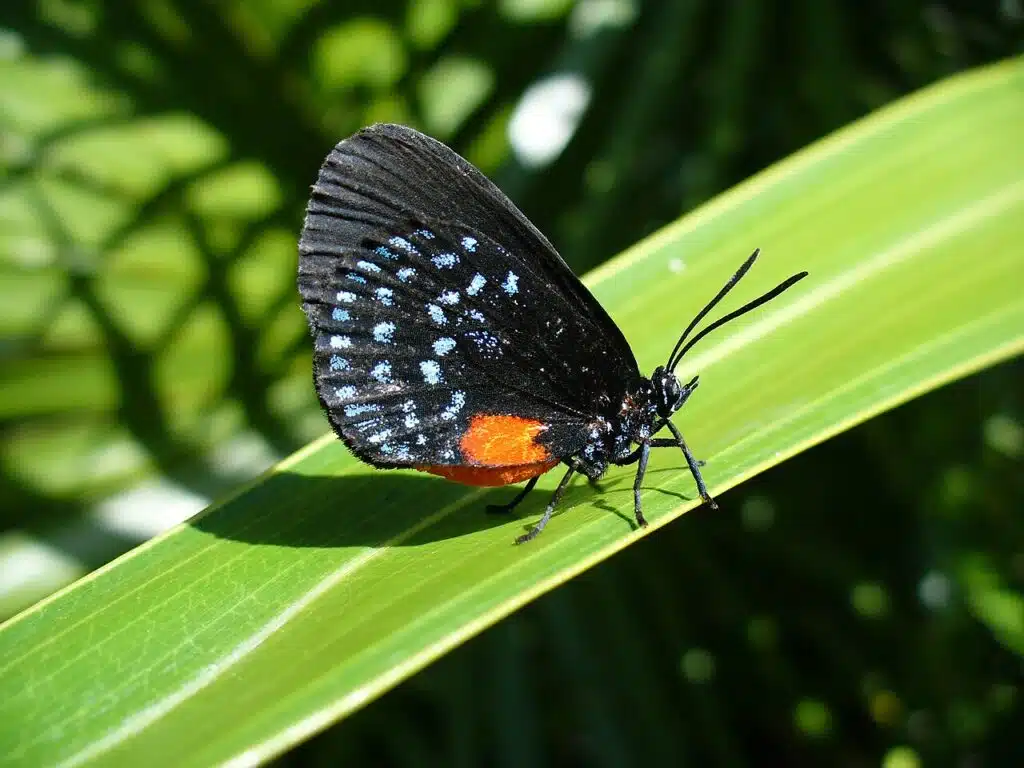
Atala (Eumaeus atala) is a type native and abundant butterfly in Florida. This species once believed to be extinct has made a considerable comeback to Southern Florida.
Atala Butterflies are known pests of ornamental palm trees of small stature. This makes them a common urban pest as well as a problem for all palm trees in the extreme South of the state.
Its pest status is not as severe as it used to be, however.
Atala caterpillars feed on these host plants absorbing their toxins. They have a bad taste for all birds and lizards that try to eat them.
Adult Atala butterflies have a black base color. They have blue spots across the wings and a red body which serves as defense as it makes the species look poisonous to its predators.
15. Great Southern White

Highly common in Florida and The Gulf Coast, the Great Southern White (Ascia monuste) is among the species with the highest change in coloring depending on the season.
Pure white wings are seen on the species most times while white with black stripes is seen in the rainy season.
Its wingspan can reach 2 inches.
Great Southern White butterflies are seen throughout the year in Florida.
Caterpillars of the species have a detrimental role with a potential pest status in certain areas of Florida and Texas.
Mustard plants are the favorite host for the Great Southern White. This species also has many other types of hosts such as cabbage.
Radish crops or radishes in the garden also attract its caterpillars.
The impact of these caterpillars can be considerable at times with complete defoliation being the primary concern.
As with most butterflies in Florida, adults switch their preferred foods.
Lantana and verbena are among the favorite plants for food when it comes to the adult Great Southern White.
As a result, the best places to see the species include locations where mustard plants, lantana, and verbena are found in high numbers.
The species is highly common in Florida gardens as a caterpillar.
It then moves on to sandy terrains for food. Florida’s coastal plains are the best place to find the species.
16. Eastern Tiger Swallowtail

Eastern Tiger Swallowtails (Papilio glaucus) are a large butterfly species native to Florida. Its presence isn’t as considerable in Southern parts of the state, however.
You can identify the Eastern Tiger Swallowtail by its mostly yellow wings. Black veins and black margins are specific to the specie.
Males have just 2 tiny orange dots on the lower hindwings to break the yellow and black pattern.
Females have a similar black and yellow base color combination with a black and yellow body. Unlike males, females also have large blue sections on the lower hindwings.
These butterflies live solitary lives except during mating periods and puddling periods when males get together to feed on dung or animal urine.
Eastern Tiger Swallowtails are also known to eat carrion being the species of Swallowtail with the most diverse diet.
Eastern Tiger Swallowtail caterpillars also feed on a wide range of trees they can even kill. They’re a common sight on wild black cherry and ash among other tree species.
Caterpillars of this genus feed on the leaves of various tree species undisturbed as they have a brown color that makes them look like bird droppings.
17. Barred Yellow

Native to Florida, Barred Yellow butterflies (Eurema daira) are some of the smallest specie in the state.
These butterflies have a wingspan barely longer than 1 inch.
The coloring of the species varies despite its name. Coloring differences are seen between seasons and between genders.
Males are mostly yellow while females can be either white or yellow.
This species lays eggs directly on plants. These host plants serve as food for the young caterpillars.
Pea family and pencil flower plants are among the favorite hosts of the caterpillars which consume their leaves.
Butterflies of this family then move on to joint vetches and other plants for nectar.
Some of the best spots to see Barred Yellow butterflies include pastures and the ever-growing dunes of the state.
18. Cloudless Sulphur

Cloudless Sulphur butterflies (Phoebis sennae) also have a yellow color but they are considerably larger than Barred Yellow butterflies.
The species has a wingspan that expands to 3.1 inches.
Butterflies of this genus also have a few small coloring differences between the sexes, just like Barred Yellow butterflies.
Male Cloudless Sulphurs have a mostly bright yellow color without any marks. Females have yellow wings with black margins.
This species of butterflies see Florida as a good state to escape changing weather.
Cloudless Sulphur butterflies are migratory. A large population of these butterflies arrives in the state in the fall.
19. Monk Skipper

Monk Skippers (Asbolis capucinus) are a species of small to medium-sized butterflies native to Florida.
This species is also seen in The Caribbean.
Monk Skippers have a brown base color and a wingspan that varies from 2 to 3 inches.
This species can be a considerable pest, but mainly in its caterpillar stage.
It infests gardens, parks, and other open areas where it feeds on palm species.
Palmetto and date palms are among their most common host species.
These types of palms and Monk Skipper caterpillars across Peninsular Florida.
Butterflies of this genus are also common in the Florida Keys.
The detrimental status of the Monk Skipper changes as the caterpillar turns into an adult. The adult butterfly starts feeding on nectar instead of eating palm leaves.
Hibiscus flowers are its main source of nectar.
20. Spicebush Swallowtail

Spicebush Swallowtails (Papilio troilus) are some of the largest black butterflies in Florida. The species is believed to mimic Pipevine Swallowtails through their blue color patterns.
This species of butterfly has black wings with white marks across the edges.
The lower part of the hindwings is black and is potentially used to keep predators away.
Mimicry isn’t only specific to adults as Spicebush Swallowtail caterpillars are also known to appear deceiving to predators.
Large eyespots on the head of the caterpillar make it look like a considerably larger species.
These caterpillars are seen on spicebush, the most common host plant of the species.
Adults are commonly seen feeding on thistles and milkweed.
21. Palamedes Swallowtail

Palamedes Swallowtail (Papilio palamedes) is a native Florida species known for multiple mimicry techniques, similar to those of the Spicebush Swallowtail.
Extra blue coloring on the hindwings of the adult and false eyes on the head of the caterpillar is the most common mimicry techniques of the species.
Palamedes Swallowtail butterflies have a base black color. 3 rows of white spots are seen along the margins of the forewings and the hindwings.
This species also has a wide white band across the hindwings.
Small black and red spots are seen on the male. Larger colorful spots are further distinguished on the hindwings of the female.
Palamedes Swallowtail butterflies are highly common around swamps and water sources as they like high humidity.
Some of their favorite host plants are also only found in swamps and riparian zones. These host species include redbay and swampbay.
Mating is a complex process with Parmededs Swallowtails. Males are known to chase females and release pheromones while flying at a close distance.
22. Cassius Blue
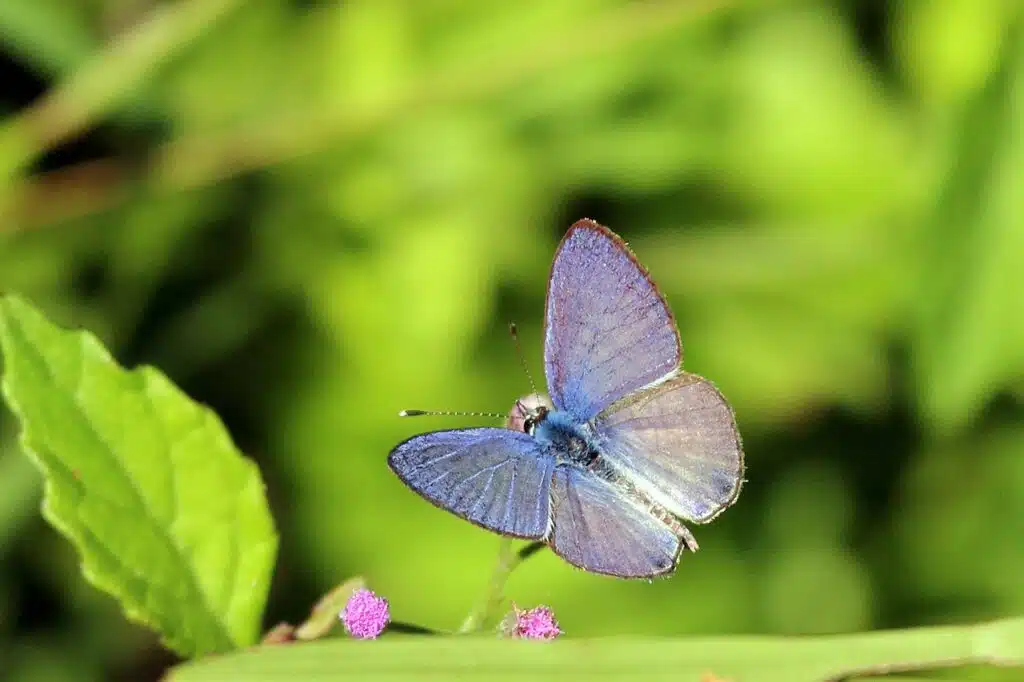
Cassius Blue (Leptotes cassius) is among the native species of Florida that keep to the Southern parts of the state.
These butterflies are known to love warm weather and to do poorly in the winter.
Cassius Blue butterflies cannot survive cold winters in temperate climates. These butterflies cannot even overwinter in Northern Florida.
They need to live in Southern Peninsula Florida and use pea family plants as hosts.
You can identify this species by its bright colorful and contrasting appearance.
These butterflies are mostly white but they also have blue and gray sections.
White sections are seen across the central section of the dorsal wings.
The margins are gray to black. Gray eyespots are further seen on the lower hindwings.
This species has light blue coloring across the white sections of the upper forewings.
Adults butterflies of the species feed on all types of peas. Milkpeas are among their favorite sources of nectar.
23. Julia Heliconian

Julia Heliconian butterflies (Dryas iulia) absorb cyanide from their host plants. This is a type of strong chemical that makes these butterflies taste bad for common predators.
The butterfly is one of the largest species in Florida as its wingspan is often longer than 80mm.
Lantanas provide the main food sources for Julia Heliconian butterflies.
You can identify this species by the colorful wings which are mostly orange. The forewings and the hindwings are all orange whole their margins are black.
The underside of the wings also has a brown and orange coloring which makes the species look like a leaf.
All caterpillars of the species have a similar orange and black look. The body is orange with long black hairs that cause rashes to the skin.
Some of these defensive traits are also seen in the adults of the species. Touching Julia Heliconian butterflies comes with rashes and red skin for most people.
24. Viceroy

Viceroy butterflies (Limenitis archippus) are some of the most common species in Florida and across the US.
These butterflies resemble Queen and Monarch butterflies with orange and black coloring.
This resemblance is believed to be the result of evolutionary mimicry in the species.
Known to grow to a large size, Viceroy butterflies are among the species that eat all types of food including feces and carrion.
These Florida butterflies are known to impact willows as they lay eggs that then hatch into caterpillars on willows and cottonwoods.
These trees aren’t widely impacted by the feeding caterpillars.
A preference for moist environments is specific to the species. Butterflies of this genus live in riparian zones where willows thrive.
25. Whirlabout

Whirlabout butterflies (Polites vibex) are native to Florida. They also live in Mexico and parts of South America.
This is a species of small colorful butterflies that can affect various types of grasses, particularly turf grasses.
Whirlabout caterpillars are among the most damaging species when it comes to grass pests as they eat grass and grass roots.
Adult butterflies of the species are identified by a yellow main color and a brown secondary color.
Yellow wings with brown margins are specific to this species. Whirlabouts are among the few species that can fold their forewings up in a triangle shape while their hindwings are flat.
Females of the species have darker colors, closer to browns.
The same color shade differences are seen between the sexes on the ventral side of the wings.
You can find these butterflies in open areas, woodlands, prairies, gardens, and on lawns across the state.
Damages inflicted by Whirlabout caterpillars to various lawns stop once they pupate and turn into nectar-feeding adults.
26. Zebra Swallowtail
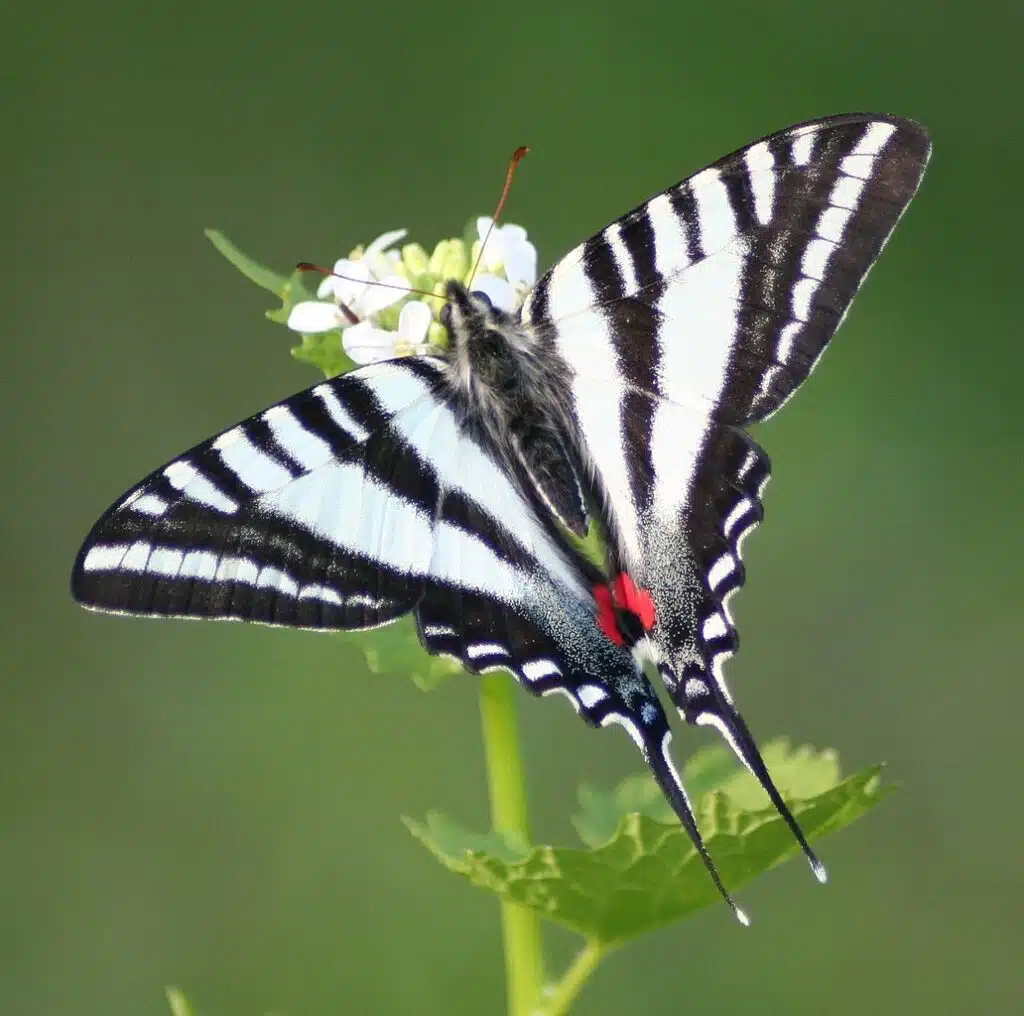
Zebra Swallowtails (Eurytides marcellus) are a large native black and white species specific to Florida and the Southeast.
This species is known for having cannibalistic caterpillars. Female Zebra Swallowtails lay eggs at a distance to reduce the cannibalistic behavior their caterpillars have.
You can identify the adult Zebra Swallowtail by its triangular shape and alternating black and white stripes across the wings.
2 long black and whitetails are also specific to this species.
Red marks are further distinguishable on the lower part of the body.
Zebra Swallowtails have a very long flight season in Florida which expands from February to December. These butterflies only appear in March or April elsewhere.
Zebra Swallowtails feed on various plants which include dogbane, mustards, and pea plants.
27. Dainty Sulphur
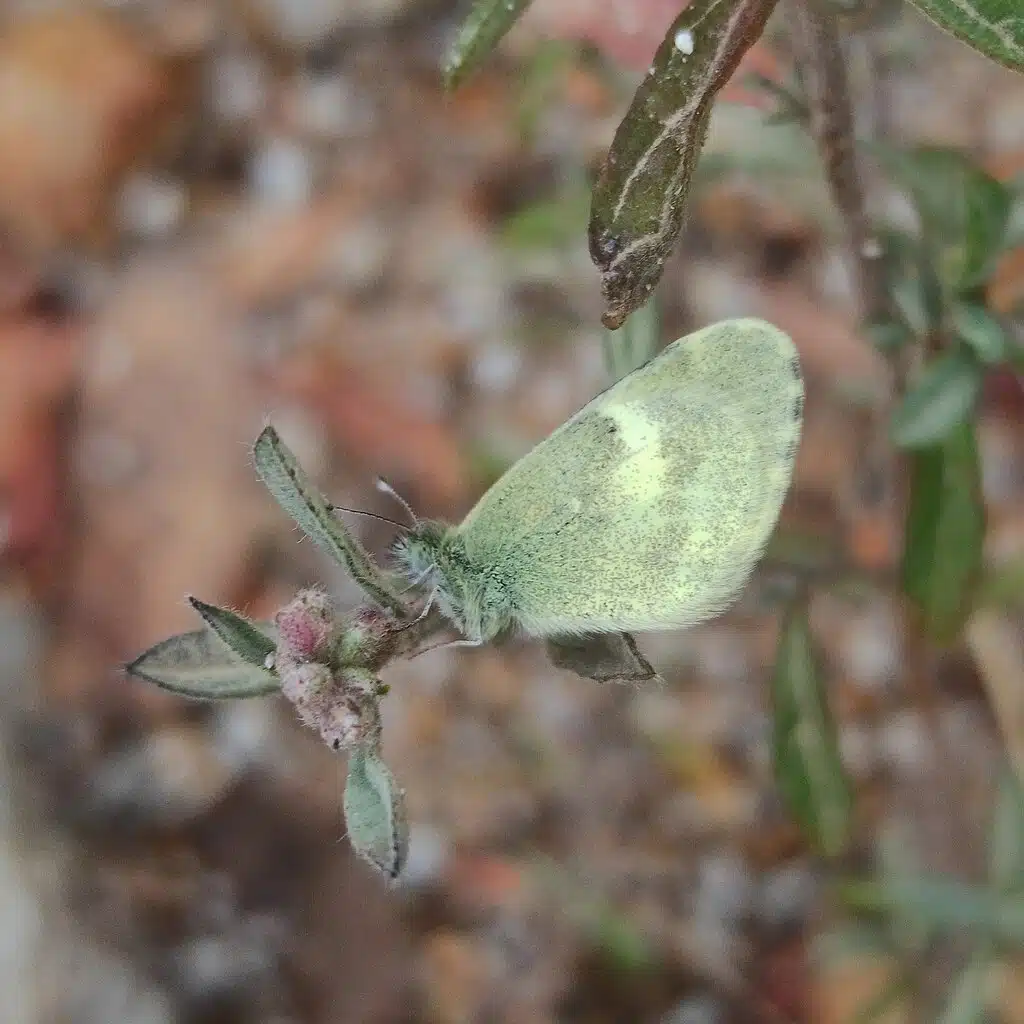
This species (Nathalis iole) is commonly seen in Florida and it’s one of the multiple migrating butterflies in the state.
A lack of adaptability to wintertime in Northern territories makes the Dainty Sulphur look for warmer climates in Florida.
Dainty Sulphur butterflies have a yellow color with black forewing tips and black marks on the lower forewings.
Colorful orange or red spots are also seen centrally.
It’s believed the colorful dorsal wings of the male are sometimes used to impress the female.
Whenever a female doesn’t show mating interest in the male the male Dainty Sulphur can show the colorful patches on its yellow dorsal wings in the last courtship attempt.
Dainty Sulphurs are well adapted to Florida habitats. These colorful butterflies are common along the coast.
They are also seen in deserts and all types of fields next to trails and roads.
Female Dainty Sulphurs are seen next to host plants such as Spanish needles and Common chickweeds.
28. Tropical Checkered-Skipper

Seen around various types of mallow plants as hosts, Tropical Checkered-Skippers (Burnsius oileus) are also native to Florida.
This species is mostly seen around the Southern parts of the state as well as in The Caribbean. 11 other sub-species of this butterfly exist, all with different colors.
Tropical Checkered-Skippers have a short wingspan of just over 1 inch. They have a checkered pattern on the dorsal wings.
The species has black and white checkered patterns across the forewings and the hindwings.
A unique blue body is specific to the species together with blue sections mainly seen closer to the body on the forewings and partially on the hindwings.
29. Pearl Crescent
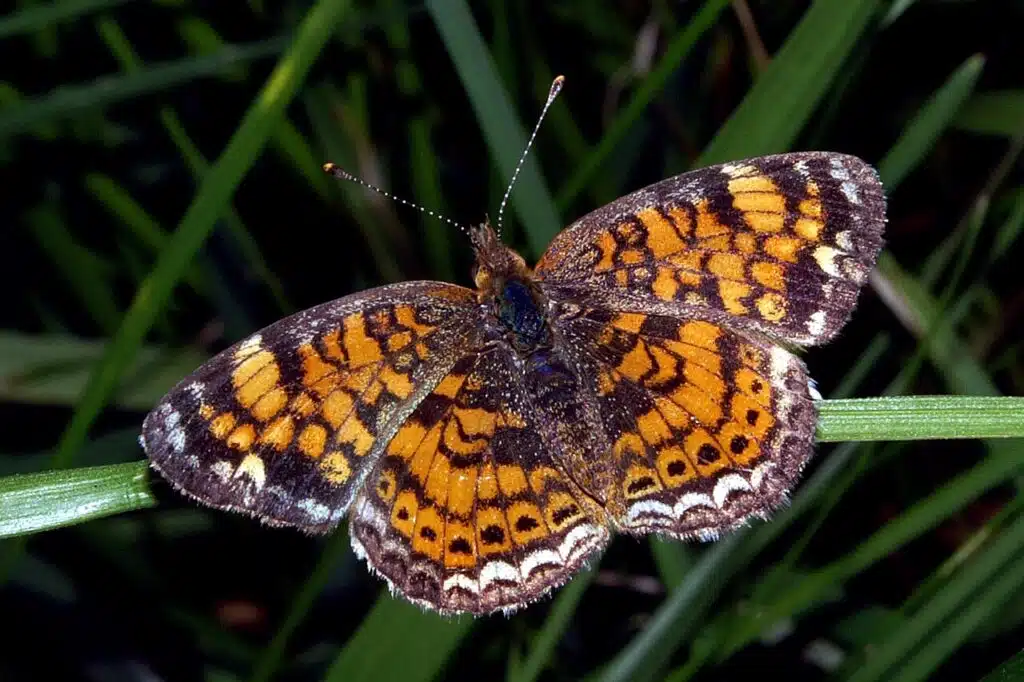
Pearl Crescents (Phyciodes tharos) are highly common across Florida. This checkered butterfly has an orange base color across its forewings and its hindwings. Black and white are secondary colors.
Black veins and marks are visible across its wings. White margins are characteristic of the forewings and the hindwings.
This butterfly species has a tan, orange, or light brown ventral wings coloring.
Florida is among its favorite states to live in since these butterflies like to live in swamps and next to swamps.
They also live in dry habitats looking for plants such as shepherd’s needle and asters.
Asters are used as host plants and females lay eggs on the underside of the leaves.
30. Gray Hairstreak
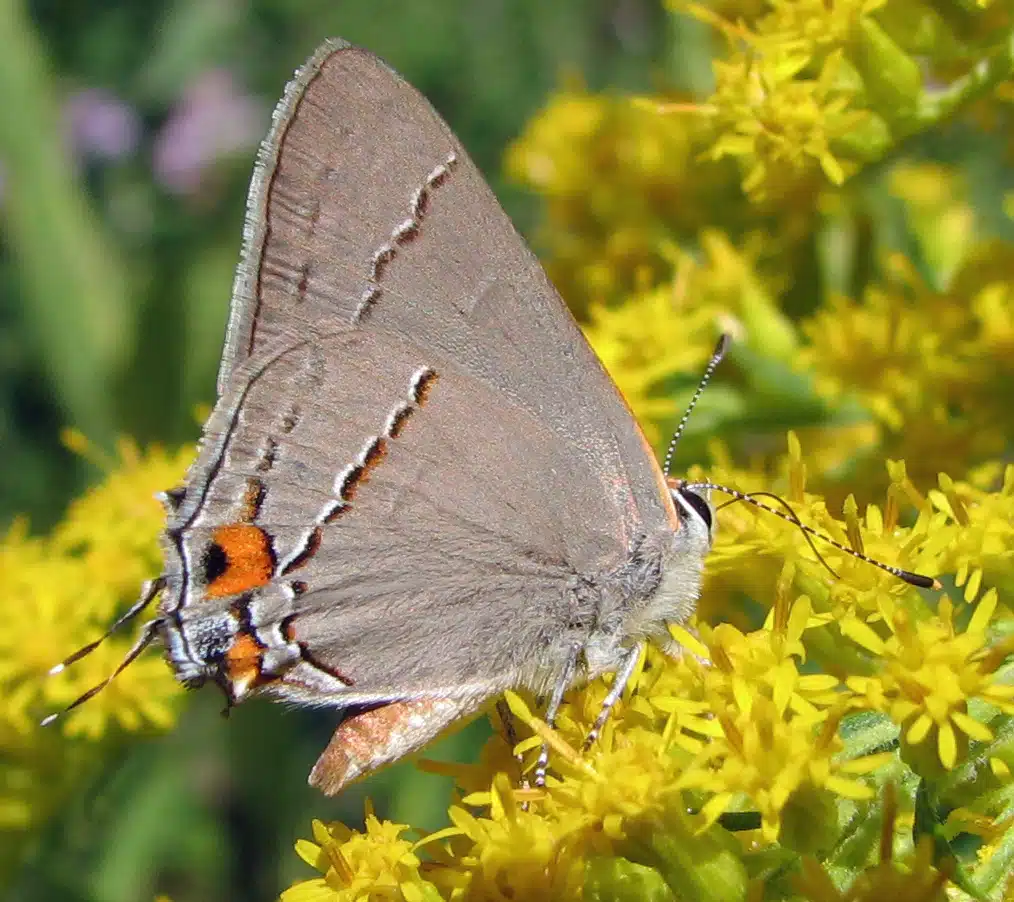
Gray Hairstreak (Strymon melinus) are dominated by gray, and blue colors with orange spots on the hindwings.
These butterflies have a distinct blue-gray color on the dorsal wings and a gray to white color on the ventral wings.
White margins are specific to the species as well.
Common all across the US, not just in Florida, Gray Hairstreak butterflies are known not to be highly dependent on host plants, as other species.
Caterpillars of the species are found on almost all types of host plants in woodlands and open areas around the state.
They eat both the flower of the host species and the leaves of the species. Some Gray Hairstreak focuses on just one of these plant parts as well.
Adults also have a varied diet of nectar according to the plants they are seen eating. Milkweed and dogbane are some of my favorites.
Clovers and mints are also welcomed by Gray Hairstreaks.
31. Carolina Satyr

Carolina Satyr butterflies (Hermeuptychia sosybius) are a Florida native species with eyespots both on the dorsal wings and on the ventral wings.
These types of butterflies are known for their large yellow eyespots on the ventral wings which are used to keep predators away.
Multiple nuance of brown and dark brown eyespots are differentiated on the dorsal side of the wings.
Carolina Satyr butterflies also have very distinct-looking caterpillars. These caterpillars have a light green body with a black head.
Seeing Carolina Satyr butterflies isn’t necessarily a good sign as the species feeds on multiple types of decorative grasses.
Eggs are commonly laid on St. Augustine and Common carpetgrasses.
32. Red-banded Hairstreak
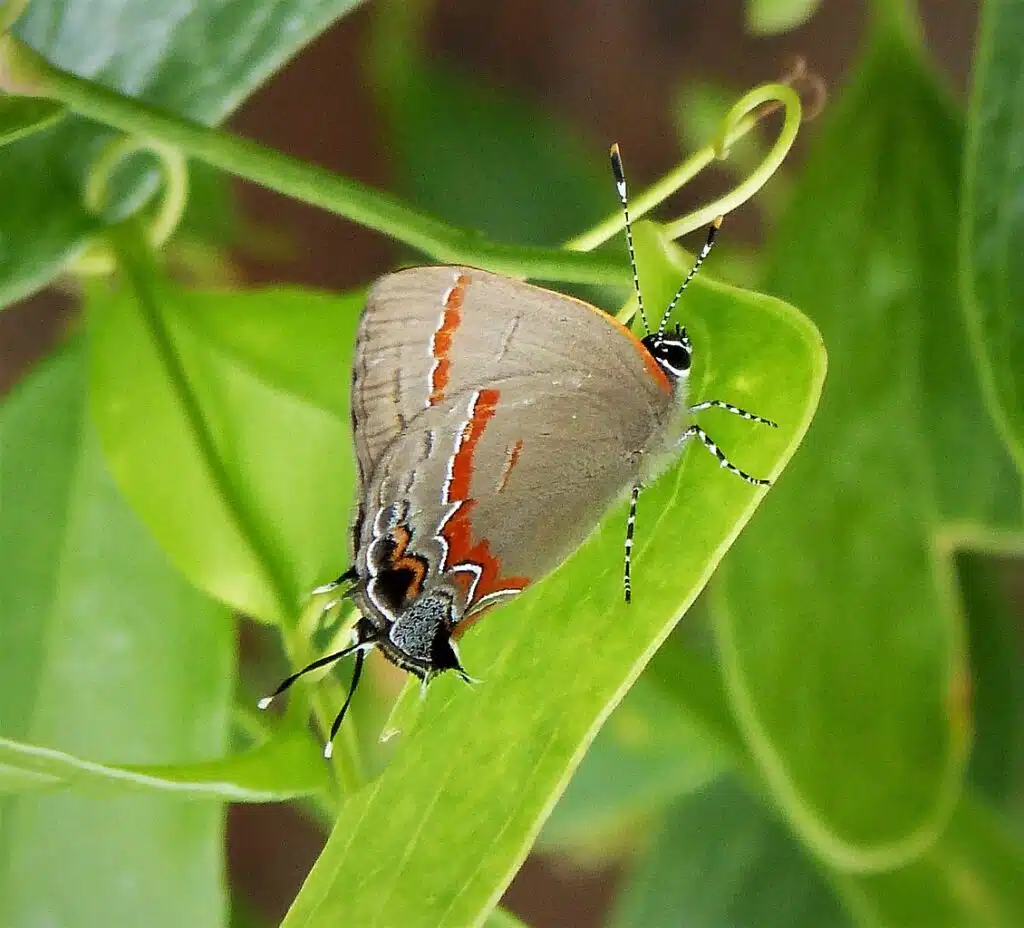
Red-banded Hairstreaks (Calycopis cecrops) get their name from the red band seen next to the margins of their wings.
This species has a mostly brown dorsal color with a red band that has white borders across the wings.
An orange band is seen on the ventral side of the wings. These colorful bands act as a warning sign to potential predators.
Apart from the colorful bands, the butterflies also have small eyespots on the margins of the ventral wings. Males have black eyespots while females have black and blue eyespots.
The larvae of the species also use coloring to defend themselves. The Red-banded Hairstreak larvae are mostly blue.
33. Dorantes Longtail

Dorantes Longtail (Thorybes dorantes) is a common species across Florida and Central America. This butterfly has a base brown color.
Similar nuances of brown are seen across its ventral wings. The species also has light veins across its ventral wings.
Dorantes Longtails are known to fold their forewings up.
The wingspan of the species varies from 35 to 43mm.
Butterflies of this species have a varied diet which includes nectar from white and yellow flowers. They also eat various types of grasses such as West Indian Marsh grasses.
Dorantes Longtails in Florida are also believed to be migratory as they have been found in other Northeastern states.
The exact habitat of the species covers tropical, sub-tropical, and temperate climates.
It’s as common in Texas as in Florida.
This species can be found even in South America with Paraguay being the Southern habitat limit.